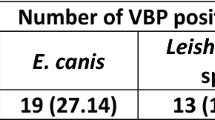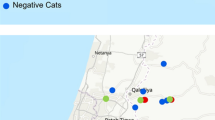Abstract
Background
Canine and feline leishmanioses are increasingly reported worldwide and represent a threat to both animal and human health. Despite their relevance, data about leishmanioses in companion animals in the east-central part of the Arabian Peninsula are unavailable. Therefore, we investigated the occurrence of Leishmania spp. in dogs and cats from Qatar.
Methods
From March 2016 to May 2018, 199 pets (120 dogs and 79 cats) living in Doha or its outskirts were included in this study. From each animal a blood sample was collected and tested for Leishmania spp. by quantitative real-time PCR.
Results
Out of the 199 animals, four (2.0%) were positive for Leishmania spp., including three dogs (2.5%) and one cat (1.3%).
Conclusions
All positive animals were born in Qatar and had not travelled overseas, suggesting that infection was locally acquired. Considering the occurrence of Leishmania spp. and its potential impact on the health of animals and humans, it is crucial to increase scientific knowledge in order to plan screening and regular prophylaxis against sand fly vectors to reduce the risk of infection.
Similar content being viewed by others
Background
Leishmaniosis is recognized by the World Health Organization (WHO) as a neglected tropical disease that represents a major public health threat worldwide [1, 2]. The disease is endemic in a variety of biogeographical environments with clinical presentations varying according to the causative species of Leishmania. As stated by the WHO, human leishmanioses have been reported in the Arabian and Gulf Peninsulas, namely Iraq, Jordan, Oman, Saudi Arabia, Syria and Yemen. Nevertheless, there are no case reports of autochthonous leishmaniosis in Qatar or in the neighboring United Arab Emirates and Bahrain [3, 4].
Qatar is a country located in the Persian Gulf, which extends northward from the main Arabian Peninsula and borders Saudi Arabia. As a result of substantial immigration, Qatar has experienced a fast demographic growth and an associated increase in the number of pets [5], which may have enhanced the risk of exotic vector-borne diseases (VBD).
In a previous study, canine and feline VBD were diagnosed in autochthonous populations of domestic dogs and cats in Qatar [6]. As no data are currently available regarding leishmaniosis in Qatar, we conducted a study to molecularly assess the occurrence of canine and feline infections with Leishmania spp. in the country.
Methods
Study location
Qatar is a peninsula in the Persian Gulf, 180 km long and 55–85 km wide, covering an area of approximately 11,000 km2, with most of its territory made of sand desert. It has an arid climate where rainfall is negligible and confined to the winter months, mainly in the form of sporadic heavy storms and downpours. Summers are characterized by high temperatures (average maximum air temperature in the hottest months, i.e. from May to October, around 40 °C), strong winds and high relative humidity. The population was estimated in 2017 to be 2,743,932 inhabitants, with the capital city Doha harboring a large percentage of the total population [5].
Animal sampling
From March 2016 to May 2018, 199 owned and stray-rescued pets (94 and 26 dogs, respectively, and 66 and 13 cats, respectively) living in Doha or its outskirts were randomly sampled. Dogs and cats were presented at Parkview Pet Center and Cityview Veterinary Clinic (Doha, Qatar) for health checks or rabies antibody titration prior to pet relocation or adoption.
A complete record was kept for each sampled animal, including species, age, sex, breed, place of birth (whenever available), lifestyle and the reasons for admissions at the veterinary clinic. Signalment of the sampled pets is summarized in Table 1.
From each animal whole blood samples were collected by venipuncture of the cephalic and/or jugular veins, in EDTA tubes or spotted onto filter papers and stored at -20 °C until use.
Molecular procedures
Genomic DNA was extracted using the QIAamp DNA Micro Kit or DNeasy Blood & Tissue Kit (Qiagen, Hilden, Germany) for blood stored on dried spots or in EDTA, respectively, according to the manufacturer’s instructions. DNA of Leishmania spp. was detected by quantitative real-time PCR (qPCR) as described elsewhere [7]. All samples were tested in duplicate and positive (DNA of pathogen-positive blood sample) and negative [pathogen-negative blood sample and no-template control (NTC)] reference samples were included in each run.
Results
Out of the 199 pets tested, four (2.0%) scored positive for Leishmania spp., including three dogs (2.5%) and one cat (1.3%). Among the positive dogs, two were Salukis and one was mixed-breed, with ages ranging from 24 to 36 months. All of them had outdoor activity, as they had been regularly taken for walks in the city and also in the mangroves and deserts, on the outskirts of Doha. Of the three animals, one was admitted because of chronic diarrhea and was diagnosed with exocrine pancreatic insufficiency, the second was an errant dog rescued from the street, and the last was admitted for an elective neutering surgery and had an unremarkable physical condition (Table 2). The only Leishmania spp.-positive cat was a domestic short-haired, 10-month-old. The cat had been a stray animal that was rescued from the streets and brought to the hospital for a health check by the owners (Table 2).
Discussion
To the best of our knowledge, this is the first detection of Leishmania spp. infection in dogs and cats from Qatar.
Dogs are the primary reservoirs of Leishmania infantum, the main causative agent of canine leishmaniosis (CanL), representing the major source of infection for human zoonotic visceral leishmaniosis, through phlebotomine sand fly bites. More recently, cats have also been diagnosed with leishmaniosis and identified as potential secondary reservoirs of L. infantum [8, 9]. Meanwhile, Leishmania major and L. tropica have been pointed out as the most common agents of cutaneous leishmaniosis in the Middle East in humans, while they are considered rare causes of CanL in the Old World. However, cutaneous manifestations of L. major in a dog and L. major and L. tropica in two other dogs from Israel have been reported [10, 11].
A previous survey [12] identified a gap of understanding and lack of awareness of the pet owner population in Qatar about the concept of zoonotic diseases and prophylactic measures to minimize their risks. Due to the zoonotic potential of leishmaniosis and the role of canine hosts as reservoirs, emphasis must be put into education of local pet owners on how to prevent leishmaniosis in their pets, an endeavor that requires collaborative efforts from human and animal health systems. Canine leishmaniosis may be a serious threat for animals travelling to and from countries where awareness on the disease and related preventative measures are unavailable [13,14,15]. Hence, further epidemiological studies, including a larger population of animals from Qatar, should be performed to obtain data on the distribution of VBD-causing pathogens in the country, and to plan prevention programs wherever necessary. Indeed, establishing control strategies against Leishmania spp. infections in humans and animals requires a thorough assessment of the prevalence of infection and investigation on the occurrence of species of phlebotomine sand flies with known competency as vectors.
Conclusions
The finding that all the positive animals were born in Qatar and had not travelled outside the country suggests that infection was locally acquired. This is, therefore, to the best of the authors’ knowledge, the first report of infection with Leishmania spp. in pets from this country. Considering the impact of leishmaniosis on the health of companion animals, it is vital to increase scientific knowledge about its epidemiological situation, and ensure routine screening and regular prophylaxis, in order to decrease exposure and contact with these pathogens.
Abbreviations
- CanL:
-
canine leishmaniosis
- VBD:
-
vector-borne diseases
- WHO:
-
World Health Organization
References
Solano-Gallego L, Miró G, Koutinas A, Cardoso L, Pennisi MG, Ferrer L, et al. LeishVet guidelines for the practical management of canine leishmaniosis. Parasit Vectors. 2011;4:86.
World Health Organization. Leishmaniasis. 2018. http://www.who.int/leishmaniasis/en/. Accessed 2 Nov 2018.
Alvar J, Velez ID, Bern C, Herrero M, Desjeux P, Cano J, et al. Leishmaniasis worldwide and global estimates of its incidence. PLoS One. 2012;7:e35671.
World Health Organization. Leishmaniases–status of endemicity of cutaneous leishmaniasis: 2017. 2018. http://apps.who.int/neglected_diseases/ntddata/leishmaniasis/leishmaniasis.html. Accessed 5 Mar 2019.
Ministry of Development Planning and Statistics. Qatar in figures 2017 (32nd issue). In: Publications, Knowledge Centre, MPDS. 2018. https://www.mdps.gov.qa/en/pages/default.aspx. Accessed 8 Nov 2018.
Alho AM, Lima C, Latrofa MS, Colella V, Ravagnan S, Capelli G, et al. Molecular detection of vector-borne pathogens in dogs and cats from Qatar. Parasit Vectors. 2017;10:298.
Francino O, Altet L, Sánchez-Robert E, Rodriguez A, Solano-Gallego L, Alberola J, et al. Advantages of real-time PCR assay for diagnosis and monitoring of canine leishmaniosis. Vet Parasitol. 2006;137:214–21.
Otranto D, Napoli E, Latrofa MS, Annoscia G, Tarallo VD, Greco G, et al. Feline and canine leishmaniosis and other vector-borne diseases in the Aeolian Islands: pathogen and vector circulation in a confined environment. Vet Parasitol. 2017;236:144–51.
Brianti E, Falsone L, Napoli E, Gaglio G, Giannetto S, Pennisi MG, et al. Prevention of feline leishmaniosis with an imidacloprid 10%/flumethrin 4.5% polymer matrix collar. Parasit Vectors. 2017;10:334.
Baneth G, Nachum-Biala Y, Shabat Simon MS, Brenner O, Gaier S, Rojas A, et al. Leishmania major infection in a dog with cutaneous manifestations. Parasit Vectors. 2016;9:246.
Baneth G, Yasur-Landau D, Gilad M, Nachum-Biala Y. Canine leishmaniosis caused by Leishmania major and Leishmania tropica: comparative findings and serology. Parasit Vectors. 2017;10:113.
Alho AM, Lima C, Colella V, Madeira de Carvalho L, Otranto D, Cardoso L. Awareness of zoonotic diseases and parasite control practices: a survey of dog and cat owners in Qatar. Parasit Vectors. 2018;11:133.
Shaw SE, Langton DA, Hillman TJ. Canine leishmaniosis in the United Kingdom: a zoonotic disease waiting for a vector? Vet Parasitol. 2009;163:81–5.
Menn B, Lorentz S, Naucke TJ. Imported and travelling dogs as carriers of canine vector-borne pathogens in Germany. Parasit Vectors. 2010;3:34.
Colella V, Hodžić A, Iatta R, Baneth G, Alić A, Otranto D. Zoonotic leishmaniasis, Bosnia and Herzegovina. Emerg Infect Dis. 2019;25:385–6.
Acknowledgements
Publication of this paper has been sponsored by Bayer Animal Health in the framework of the 14th CVBD World Forum Symposium.
Funding
This study was financially supported by the Department of Veterinary Medicine, University of Bari, Italy, and by the Project UID/CVT/00276/2013 (CIISA).
Availability of data and materials
All data generated or analyzed during the study are included in the article.
Authors’ contributions
CL conducted clinical examination and sample collection, and drafted the manuscript. VC and MSL performed molecular analysis, contributed with data analysis and revised the manuscript. LC helped conceive the study, analysed data and revised the manuscript. DO reviewed the manuscript. AMA conceived the study, analysed data and drafted the manuscript. All authors read and approved the final manuscript.
Ethics approval and consent to participate
All clinical procedures were in accordance with Portuguese (Decree-Laws no. 314/2003 and no. 113/2013) and European legislation for the protection of animals. Owners provided their oral informed consent.
Consent for publication
Not applicable.
Competing interests
The authors declare that they have no competing interests.
Publisher’s Note
Springer Nature remains neutral with regard to jurisdictional claims in published maps and institutional affiliations.
Author information
Authors and Affiliations
Corresponding author
Rights and permissions
Open Access This article is distributed under the terms of the Creative Commons Attribution 4.0 International License (http://creativecommons.org/licenses/by/4.0/), which permits unrestricted use, distribution, and reproduction in any medium, provided you give appropriate credit to the original author(s) and the source, provide a link to the Creative Commons license, and indicate if changes were made. The Creative Commons Public Domain Dedication waiver (http://creativecommons.org/publicdomain/zero/1.0/) applies to the data made available in this article, unless otherwise stated.
About this article
Cite this article
Lima, C., Colella, V., Latrofa, M.S. et al. Molecular detection of Leishmania spp. in dogs and a cat from Doha, Qatar. Parasites Vectors 12, 125 (2019). https://doi.org/10.1186/s13071-019-3394-y
Received:
Accepted:
Published:
DOI: https://doi.org/10.1186/s13071-019-3394-y




